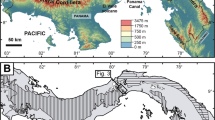Abstract
We show that volcanic activity was occurring in the NW Pacific seafloor areas adjacent to Japan, the Kuril Islands, Kamchatka, and the Commander Islands during Pliocene to Pleistocene time. The activity was highest in two areas. At least three major volcanoes originated and were active in the southern area behind the Japan trench off Honshu and Hokkaido. Lava-dominated Pleistocene stratovolcanoes originated and were active in the Detroit and Wayne volcanic massifs in the central area, on the Detroit rise, which is the northern termination of the Emperor Ridge. As well, there was a large (42 km across) volcano-tectonic structure that was previously unknown, viz., a deep-sea calderoida. Somewhat north where the margin of the Obruchev Rise is adjacent to the deep-sea Kamchatka trench, a volcano (?) was active during Pliocene time whose present-day summit is at a height of –713 m. We show that the Detroit Seamount rise is a seafloor block that was uplifted in the Pliocene in the form of a horst and showed Pliocene–Pleistocene volcanic activity.




Similar content being viewed by others
REFERENCES
Cao, L.-Q., Arculus, R.J., and McKelvey, B.C., Geochemistry and petrology of volcanic ashes recovered from sites 881 through 884: A temporal record of Kamchatka and Kurile volcanism, Proceedings of the Ocean Drilling Program Scientific Results, Rea, D.K., Basov, L.A., Scholl, D.W., and Allan, J.F., Eds., 1995, vol. 145, pp. 345–381.
Carte Internationale du Monde au 1 : 1 000 000, North Japan, Geographical Survey Institute, 1966.
Cruise Reports, Sonne Cruise SO-201, Leg 2, 2009.
Duncan, R.A. and Keller, R.A., Radiometric ages for basement rocks from the Emperor Seamounts, ODR Leg 197, Geochem. Geophys., 2004, no. 5, Q08L03. https://doi.org/10.1029/2004G000704
Initial Core Descriptions, Deep Sea Drilling Project Leg 56, 1977.
Initial Reports of the Deep Drilling Project, 1973, vol. 19.
Kamchatka, Kurilskie i Komandorskie ostrova (Kamchatka, the Kuril and Commander Islands), Luchitsky, I.V., Ed., Moscow: Nauka, 1974.
Keller, R.A., Fisk, M.R., and Duncan, R.A., Geochemistry and 40Ar/39Ar geochronology of basalts from ODP Leg 145, Proc. Ocean Drill. Program Sci. Results, vol. 145, 1995, pp. 333–344.
Melekestsev, I.V., The vortical volcanic hypothesis and some perspectives of its application, in Problemy glubinnogo magmatizma (Problems of Deep Magmatism), Moscow: Nauka, 1979, pp. 125–155.
Melekestsev, I.V., A new type of volcano-tectonic morphostructure: a 42-rm deep-sea calderoida on the Detroit Seamount rise, northwest Pacific, Geomorfologiya, 2018, no. 3, pp. 82–92.
Melekestsev, I.V. and Kurbatov, A.V., The frequency of major paleoseismic events in the northwestern coast and in the Commander Basin of the Bering Sea during Late Pleistocene to Holocene time, Vulkanol. Seismol., 1997, no. 3, pp. 3–11.
Melekestsev, I.V., Kurbatov, A.V., Pevzner, M.M., and Sulerzhitsky, L.D., Prehistorical tsunamis and large earthquakes in the Kamchatsky Peninsula, Kamchatka: Tephrochronological surveys, Vulkanol. Seismol., 1994, no. 5, pp. 106–115.
Melekestsev, I.V. and Slezin, Yu.B., Magma superflows in the Bering Sea. Part 1. The model and the geological and geomorphologic features, J. Volcanol. Seismol., 2017a, vol. 11, no. 1, pp. 20–32.
Melekestsev, I.V. and Slezin, Yu.B., Magma superflows in the Bering Sea. 2. The mechanism of origin and movement and its evolution in time and space, J. Volcanol. Seismol., 2017b, vol. 11, no. 2, pp. 113–122.
Mezhdunarodnyi geologo-geofizicheskii atlas Tikhogo okeana (International Geological and Geophysical Atlas of the Pacific Ocean), Udintsev, G.B., Ed., Moscow–St. Petersburg.: MOK (YuNESKO), RAN, FGPU PKO “Kartografiya”, GUNiO, 2003.
Rea, D.K., Basov, L.A., Scholl, D.W., and Allan, J.F., Procceding of the Ocean Drilling Program Scientific Results, 1995, vol. 145.
Shipboard Scientific Party, Leg 197 summary, Proc. Ocean Drill. Program Initial Results, 2002, vol. 197.
Tarduno, J.A., Duncan, R.A., Scholl, D.W., et al., Proceedings of the Ocean Drilling Program, Initial Reports, 2002, vol. 197.
ACKNOWLEDGMENTS
I thank my colleagues, O.V. Dirksen for a helpful discussion of the problems raised in the present paper and R.R. Kurmashova for preparation of the paper.
Funding
This study was supported by the Russian Foundation for Basic Research, project no. 15-05-05505.
Author information
Authors and Affiliations
Corresponding author
Additional information
Translated by A. Petrosyan
Rights and permissions
About this article
Cite this article
Melekestsev, I.V. Pliocene–Pleistocene Deep-Sea Volcanoes in the Northwest Pacific. J. Volcanolog. Seismol. 14, 18–29 (2020). https://doi.org/10.1134/S0742046320010042
Received:
Revised:
Accepted:
Published:
Issue Date:
DOI: https://doi.org/10.1134/S0742046320010042




